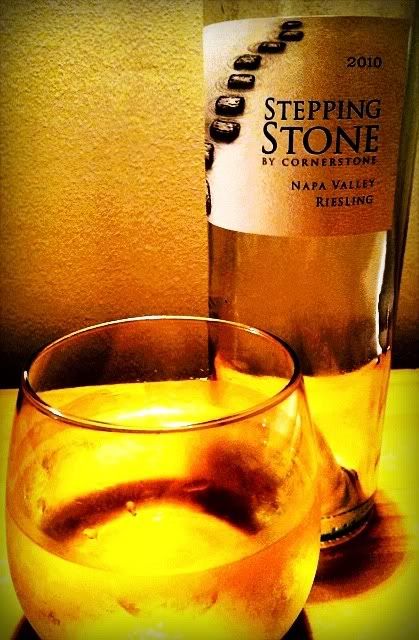Recently, my wife had a hair appointment in Beverly Hills, followed immediately by a girlfriend lunch, also in Beverly Hills. I dropped her off and ran a few errands, but still had a lot of time to kill in Beverly Hills. I turned to the wine.
I had been meaning to explore few wine-oriented places in the Hills of Beverly for quite some time, and this sunny Saturday afternoon seemed perfectly suited to the occasion.
It was around noon - okay, it was 11:32 - when I walked into Enoteca Drago on Cañon Drive. There are, maybe, a dozen Italian restaurants in Beverly Hills. About 11 of them are owned and operated by the Drago family. That’s alright by me, as I always have wonderful food and a thoughtful wine list at a Drago restaurant.
Enoteca is even more focused on wine than the other family locations, since it is a wine bar. The menu offers 11 different flights of wine in the $15 - $20 range, while single glasses are in the $9 - $23 neighborhood. The wine list has lots of variety, including late harvest selections, Ports and Grappa choices, too. There’s also a complete menu of Italian fare to pair with the wines.
I chose a flight of three medium-bodied, semi-aromatic white wines for $17. Included in the flight were the following wines, with my tasting notes:
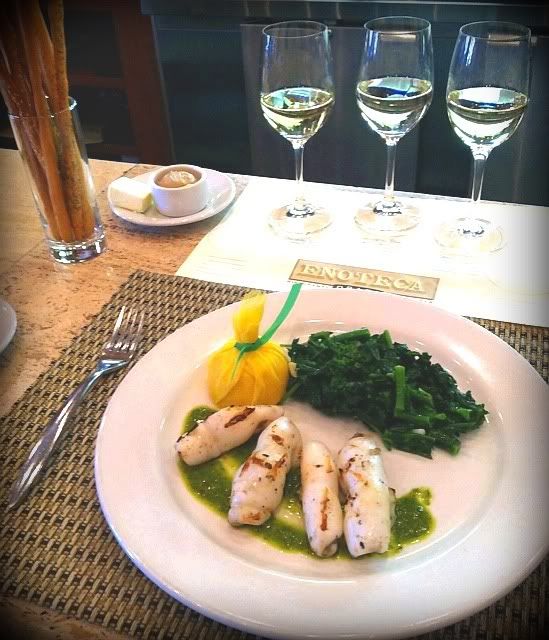 Greco di Tufo, Terradora DiPaolo, Campania 2010 -
Greco di Tufo, Terradora DiPaolo, Campania 2010 -
Richest color of the trio. Apricot and ocean on the nose, golden apples with a hint of honey on the palate. Minerals abound, great finish. Greco is an Italian grape, thought to be of Greek origin.
Sauvignon Blanc, Joel Gott, Napa Valley 2010
Palest of the three, almost clear. Grassy and fruity notes make up the nose, with melon and herbal notes present. Peach and apple cobbler flavors are on the palate. The cobbler is a complete surprise, but it works.
Gavi, Villa Sparina, Piemonte 2010
Medium straw in color the light nose is very hard to pick up. What is that lovely taste? It seems like cantaloupe or honeydew. There’s a lot of minerality, too. Wine from Gavi area of Piemonte is made exclusively of the Cortese grape.
I ordered the calamari alla griglia with this flight. All three wines pair well with the calamari, the Gavi matches it the best. The Joel Gott Sauvignon Blanc went best with the rapini. By the way, when grilled calamari is offered, it should always have the grill marks on it. It does at Enoteca Drago.
After checking in with the wife and friend at Cafe Roma (oddly enough, not a Drago restaurant) I was invited to go away a while longer, as the chatting got out of hand.
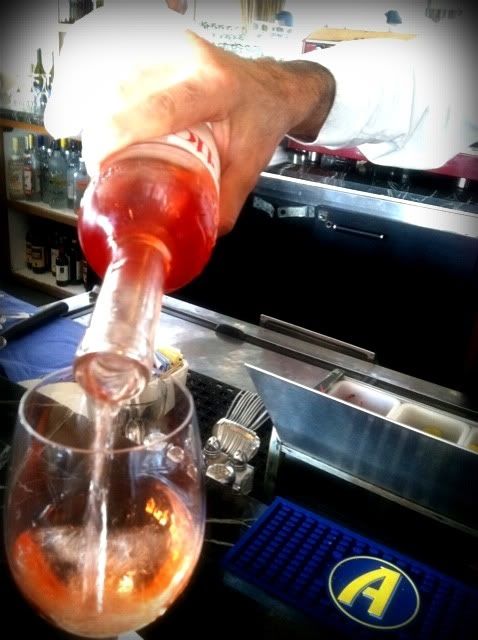 Just up the street is Il Pastaio. Yes, it’s another Drago restaurant. This place looked really busy and festive at 1:00 or so Saturday. As I approached, a guy in a big, white Cadillac pulled up, with Italian music blaring at festival volume from his car stereo. As he made the corner, with the window down, he looked over at the sidewalk lunchers and led with his finger to the music.
Just up the street is Il Pastaio. Yes, it’s another Drago restaurant. This place looked really busy and festive at 1:00 or so Saturday. As I approached, a guy in a big, white Cadillac pulled up, with Italian music blaring at festival volume from his car stereo. As he made the corner, with the window down, he looked over at the sidewalk lunchers and led with his finger to the music.
The mobile maestro was obviously enjoying the moment to share his passion, and I overheard a guest comment, “Wow, that’s real.” Indeed. I stepped inside and took a seat at the bar.
I only examined the wine list for rosé, as that’s what I really wanted. The Chiaretto Provenza is $10.50 by the glass.
Made with Groppello, Marzemino, Sangiovese and Barbera grapes, the wine hails from the area near Lake Garda in the northern part of Italy. The winery, Azienda Agricola Provenza, is located in the Lombardy region. Lake Garda has a special microclimate in which palm, olive and lemon trees thrive practically at the foot of the Alps.
The wine is a nice, rich, salmon color and the ice cold status at which it’s served makes it a little hard to discern too much on the nose. The palate shows bright cherry and strawberry fruit with a hint of raspberry tartness. The wine is dry and crisp - very refreshing. The finish is good, and minerals are the last thing remembered after the sip is gone.
I had been meaning to explore few wine-oriented places in the Hills of Beverly for quite some time, and this sunny Saturday afternoon seemed perfectly suited to the occasion.
It was around noon - okay, it was 11:32 - when I walked into Enoteca Drago on Cañon Drive. There are, maybe, a dozen Italian restaurants in Beverly Hills. About 11 of them are owned and operated by the Drago family. That’s alright by me, as I always have wonderful food and a thoughtful wine list at a Drago restaurant.
Enoteca is even more focused on wine than the other family locations, since it is a wine bar. The menu offers 11 different flights of wine in the $15 - $20 range, while single glasses are in the $9 - $23 neighborhood. The wine list has lots of variety, including late harvest selections, Ports and Grappa choices, too. There’s also a complete menu of Italian fare to pair with the wines.
I chose a flight of three medium-bodied, semi-aromatic white wines for $17. Included in the flight were the following wines, with my tasting notes:
 Greco di Tufo, Terradora DiPaolo, Campania 2010 -
Greco di Tufo, Terradora DiPaolo, Campania 2010 -Richest color of the trio. Apricot and ocean on the nose, golden apples with a hint of honey on the palate. Minerals abound, great finish. Greco is an Italian grape, thought to be of Greek origin.
Sauvignon Blanc, Joel Gott, Napa Valley 2010
Palest of the three, almost clear. Grassy and fruity notes make up the nose, with melon and herbal notes present. Peach and apple cobbler flavors are on the palate. The cobbler is a complete surprise, but it works.
Gavi, Villa Sparina, Piemonte 2010
Medium straw in color the light nose is very hard to pick up. What is that lovely taste? It seems like cantaloupe or honeydew. There’s a lot of minerality, too. Wine from Gavi area of Piemonte is made exclusively of the Cortese grape.
I ordered the calamari alla griglia with this flight. All three wines pair well with the calamari, the Gavi matches it the best. The Joel Gott Sauvignon Blanc went best with the rapini. By the way, when grilled calamari is offered, it should always have the grill marks on it. It does at Enoteca Drago.
After checking in with the wife and friend at Cafe Roma (oddly enough, not a Drago restaurant) I was invited to go away a while longer, as the chatting got out of hand.
 Just up the street is Il Pastaio. Yes, it’s another Drago restaurant. This place looked really busy and festive at 1:00 or so Saturday. As I approached, a guy in a big, white Cadillac pulled up, with Italian music blaring at festival volume from his car stereo. As he made the corner, with the window down, he looked over at the sidewalk lunchers and led with his finger to the music.
Just up the street is Il Pastaio. Yes, it’s another Drago restaurant. This place looked really busy and festive at 1:00 or so Saturday. As I approached, a guy in a big, white Cadillac pulled up, with Italian music blaring at festival volume from his car stereo. As he made the corner, with the window down, he looked over at the sidewalk lunchers and led with his finger to the music. The mobile maestro was obviously enjoying the moment to share his passion, and I overheard a guest comment, “Wow, that’s real.” Indeed. I stepped inside and took a seat at the bar.
I only examined the wine list for rosé, as that’s what I really wanted. The Chiaretto Provenza is $10.50 by the glass.
Made with Groppello, Marzemino, Sangiovese and Barbera grapes, the wine hails from the area near Lake Garda in the northern part of Italy. The winery, Azienda Agricola Provenza, is located in the Lombardy region. Lake Garda has a special microclimate in which palm, olive and lemon trees thrive practically at the foot of the Alps.
The wine is a nice, rich, salmon color and the ice cold status at which it’s served makes it a little hard to discern too much on the nose. The palate shows bright cherry and strawberry fruit with a hint of raspberry tartness. The wine is dry and crisp - very refreshing. The finish is good, and minerals are the last thing remembered after the sip is gone.

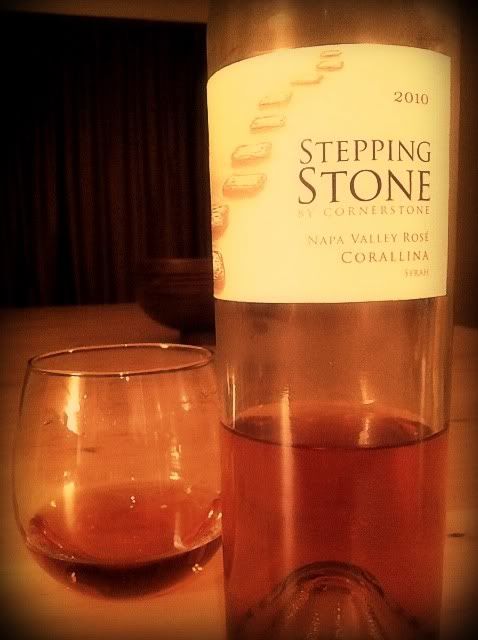

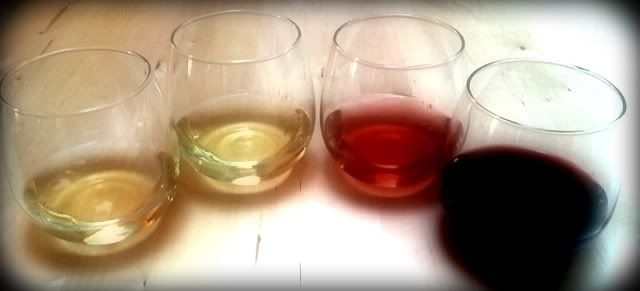 South Coast Winery Sauvignon Blanc Musqué Clone 2009
South Coast Winery Sauvignon Blanc Musqué Clone 2009 
